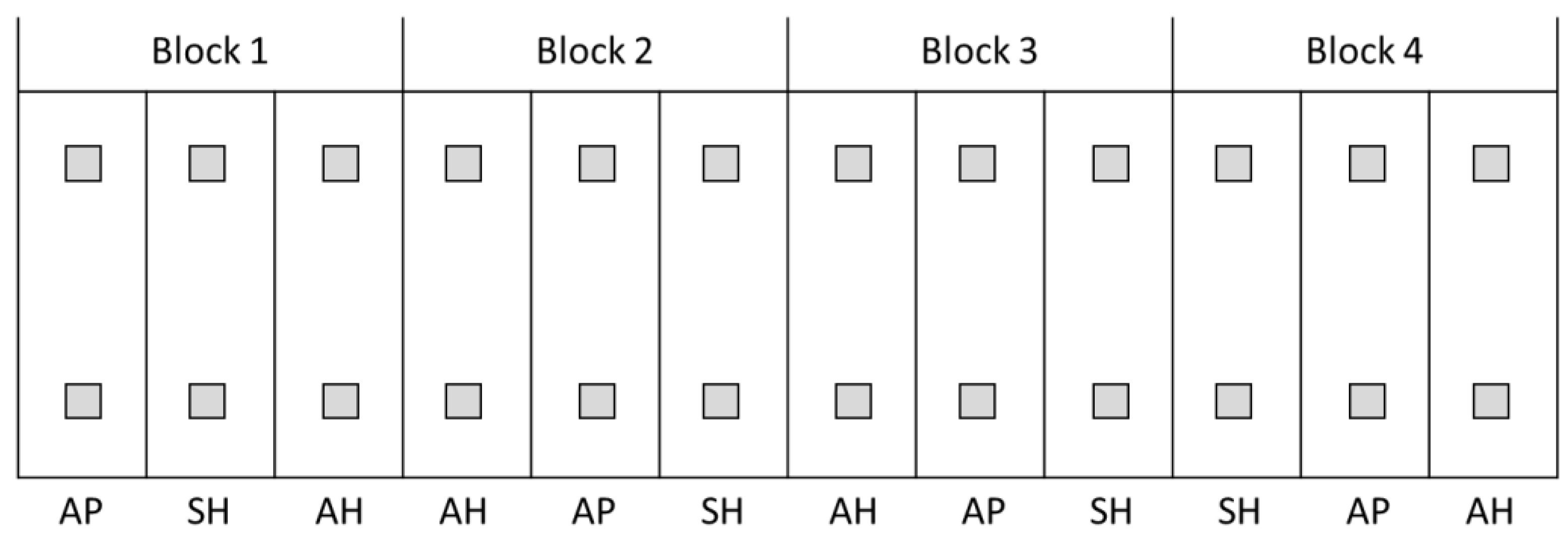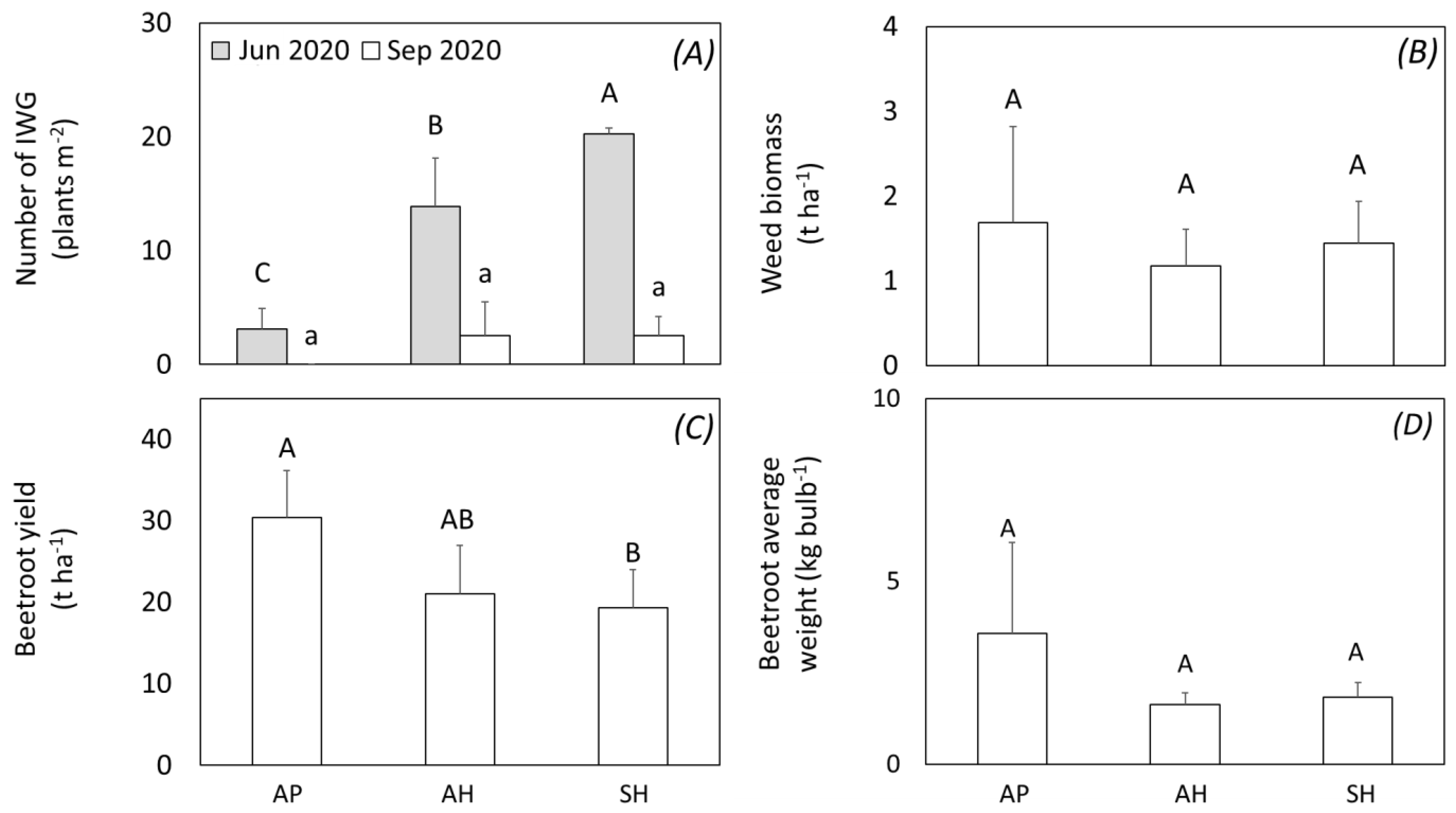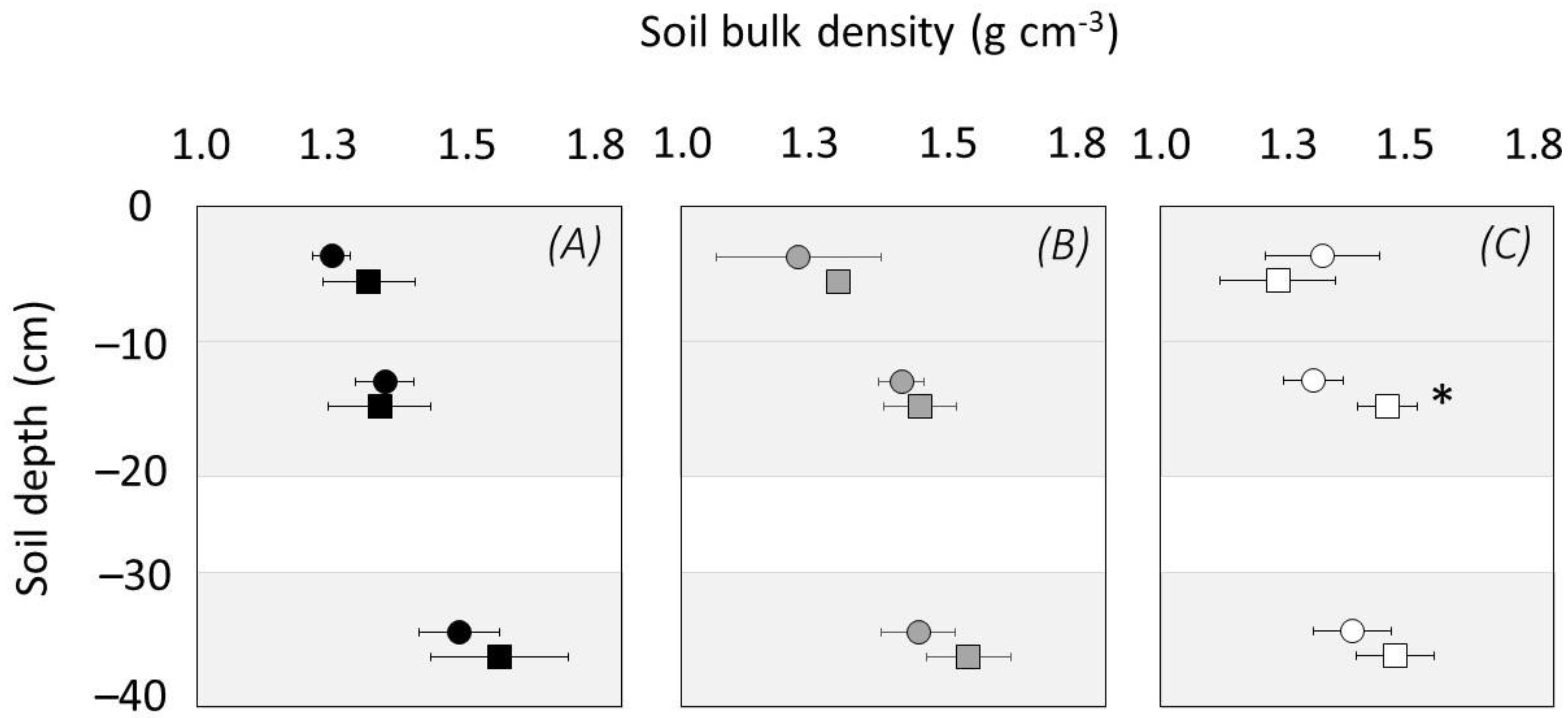The Perennial Grain Crop Thinopyrum intermedium (Host) Barkworth & D.R. Dewey (Kernza™) as an Element in Crop Rotations: A Pilot Study on Termination Strategies and Pre-Crop Effects on a Subsequent Root Vegetable
Abstract
:1. Introduction
2. Materials and Methods
Statistics
3. Results
4. Discussion
5. Conclusions
Author Contributions
Funding
Acknowledgments
Conflicts of Interest
References
- FAO. Perennial Crops for Food Security; FAO Expert Workshop: Rome, Italy, 2013. [Google Scholar]
- Culman, S.W.; Snapp, S.S.; Ollenburger, M.; Basso, B.; DeHaan, L.R. Soil and Water Quality Rapidly Responds to the Perennial Grain Kernza Wheatgrass. Agron. J. 2013, 105, 735–744. [Google Scholar] [CrossRef] [Green Version]
- Jungers, J.M.; DeHaan, L.H.; Mulla, D.J.; Sheaffer, C.C.; Wyse, D.L. Reduced nitrate leaching in a perennial grain crop compared to maize in the Upper Midwest, USA. Agric. Ecosyst. Environ. 2018, 272, 63–73. [Google Scholar] [CrossRef]
- Sprunger, C.D.; Culman, S.; Peralta, A.L.; DuPont, S.T.; Lennon, J.T.; Snapp, S. Perennial grain crop roots and nitrogen management shape soil food webs and soil carbon dynamics. Soil Biol. Biochem. 2019, 137, 107573. [Google Scholar] [CrossRef]
- Dominschek, R.; Arrobas, A.; Barroso, M.; Lang, R.; De Moraes, A.; Sulc, R.M.; Schuster, M.Z. Crop rotations with temporary grassland shifts weed patterns and allows herbicide-free management without crop yield loss. J. Clean. Prod. 2021, 306, 127140. [Google Scholar] [CrossRef]
- Watson CAAtkinson, D.; Gosling, P.; Jackson, L.R.; Rayns, F.W. Managing soil fertility in organic farming systems. Soil Use Manag. 2002, 18, 239–247. [Google Scholar] [CrossRef] [Green Version]
- Vellinga, T.; Dasselaar, A.V.D.P.-V.; Kuikman, P. The impact of grassland ploughing on CO2 and N2O emissions in the Netherlands. Nutr. Cycl. Agroecosystems 2004, 70, 33–45. [Google Scholar] [CrossRef]
- Reinsch, T.; Loges, R.; Kluß, C.; Taube, F. Effect of grassland ploughing and reseeding on CO2 emissions and soil carbon stocks. Agric. Ecosyst. Environ. 2018, 265, 374–383. [Google Scholar] [CrossRef]
- Alcántara, V.; Don, A.; Well, R.; Nieder, R. Deep ploughing increases agricultural soil organic matter stocks. Glob. Chang. Biol. 2016, 22, 2939–2956. [Google Scholar] [CrossRef]
- Alvarez, C.R.; Álvarez, R. Short-term effects of tillage systems on active soil microbial biomass. Biol. Fertil. Soils 2000, 31, 157–161. [Google Scholar] [CrossRef]
- Chen, X.; Liang, A.; Wu, D.; McLaughlin, N.B.; Jia, S.; Zhang, S.; Zhang, Y.; Huang, D. Tillage-induced effects on organic carbon in earthworm casts through changes in their physical and structural stability parameters. Ecol. Indic. 2021, 125, 107521. [Google Scholar] [CrossRef]
- Peigné, J.; Lefevre, V.; Vian, J.-F.; Fleury, P. Conservation Agriculture in Organic Farming: Experiences, Challenges and Opportunities in Europe. In Conservation Agriculture; Springer: Cham, Switzerland, 2014; pp. 559–578. [Google Scholar] [CrossRef]
- Bond, W.; Grundy, A.C. Non-chemical weed management in organic farming systems. Weed Res. 2001, 41, 383–405. [Google Scholar] [CrossRef]
- Melander, B.; Rasmussen, I.A.; Bàrberi, P. Integrating physical and cultural methods of weed control— examples from European research. Weed Sci. 2005, 53, 369–381. [Google Scholar] [CrossRef]
- Duiker, S.W.; Beegle, D.B. Soil fertility distributions in long-term no-till, chisel/disk and moldboard plow/disk systems. Soil Tillage Res. 2006, 88, 30–41. [Google Scholar] [CrossRef]
- Lönnstorp Field Research Station. Soil Data from Lönnstorp. SITES Data Portal. 2021. Available online: https://data.fieldsites.se/portal/ (accessed on 10 November 2021).
- Swedish Meteorological and Hydrological Institute. 2021. Available online: www.smhi.se (accessed on 1 October 2021).
- Zhang, X.; Sallam, A.; Gao, L.; Kantarski, T.; Poland, J.; DeHaan, L.; Wyse, D.L.; Anderson, J.A. Establishment and Optimization of Genomic Selection to Accelerate the Domestication and Improvement of Intermediate Wheatgrass. Plant Genome 2016, 9, 1–18. [Google Scholar] [CrossRef] [PubMed] [Green Version]
- KRAV 2021. Regler för KRAV-Certifierad Produktion Utgåva; KRAV Ekonomisk Förening: Uppsala, Sweden, 2021. [Google Scholar]
- Ringselle, B.; Bertholtz, E.; Magnuski, E.; Brandsæter, L.O.; Mangerud, K.; Bergkvist, G. Rhizome Fragmentation by Vertical Disks Reduces Elymus repens Growth and Benefits Italian Ryegrass-White Clover Crops. Front. Plant Sci. 2018, 8, 2243. [Google Scholar] [CrossRef]
- Shokati BAhangar, A.G. Effect of conservation tillage on soil fertility factors: A review. Int. J. Biosci. 2014, 4, 144–156. [Google Scholar]
- Young, M.D.; Ros, G.H.; de Vries, W. Impacts of agronomic measures on crop, soil, and environmental indicators: A review and synthesis of meta-analysis. Agric. Ecosyst. Environ. 2021, 319, 107551. [Google Scholar] [CrossRef]
- Krauss, M.; Berner, A.; Perrochet, F.; Frei, R.; Niggli, U.; Mäder, P. Enhanced soil quality with reduced tillage and solid manures in organic farming–a synthesis of 15 years. Sci. Rep. 2020, 10, 1–12. [Google Scholar] [CrossRef] [Green Version]
- Meurer, K.H.; Haddaway, N.R.; Bolinder, M.A.; Kätterer, T. Tillage intensity affects total SOC stocks in boreo-temperate regions only in the topsoil—A systematic review using an ESM approach. Earth-Sci. Rev. 2017, 177, 613–622. [Google Scholar] [CrossRef]
- Schneider, F.; Don, A.; Hennings, I.; Schmittmann, O.; Seidel, S.J. The effect of deep tillage on crop yield—What do we really know? Soil Tillage Res. 2017, 174, 193–204. [Google Scholar] [CrossRef]
- Hefner, M.; Labouriau, R.; Nørremark, M.; Kristensen, H.L. Controlled traffic farming increased crop yield, root growth, and nitrogen supply at two organic vegetable farms. Soil Tillage Res. 2019, 191, 117–130. [Google Scholar] [CrossRef]
- Yasaminshirazi, K.; Hartung, J.; Groenen, R.; Heinze, T.; Fleck, M.; Zikeli, S.; Graeff-Hönninger, S. Agronomic Performance of Different Open-Pollinated Beetroot Genotypes Grown Under Organic Farming Conditions. Agronomy 2020, 10, 812. [Google Scholar] [CrossRef]
- Buhler, D.D.; Hartzler, R.G.; Forcella, F. Implications of weed seedbank dynamics to weed management. Weed Sci. 1997, 45, 329–336. [Google Scholar] [CrossRef]
- Grime, J.P. Primary strategies in plants. Trans. Bot. Soc. Edinb. 1979, 43, 151–160. [Google Scholar] [CrossRef]
- Gallandt, E.R. How can we target the weed seedbank? Weed Sci. 2006, 54, 588–596. [Google Scholar] [CrossRef]



| Year | Month | Day | Crop | Management | Treatment | Sampling |
|---|---|---|---|---|---|---|
| 2019 | August | 14–15 | IWG | Bulk dens | ||
| September | 16 | Harvest | All | |||
| October | 1 | Cutting | All | |||
| 2 | Harrowing (7 cm) | Autumn harrowing (AH) | ||||
| 11 | Ploughing (25 cm) | Autumn ploughing (AP) | ||||
| 2020 | April | 23 | Harrowing (7 cm) | Spring harrosing (SH) | ||
| 27 | Mechanical weed management (10 cm) | All | ||||
| May | 18 | Mechanical weed management (10 cm) | All | |||
| June | 2 | Mechanical weed management (10 cm) | All | |||
| 3 | Beetroot | Sowing | All | |||
| 26 | IWGA | |||||
| July | 10 | Mechanical weed management: Row-harrowing | All | |||
| 23 | Mechanical weed management: Row-harrowing | All | ||||
| September | 21 | Harvest | All | IWG A, weeds A,B | ||
| September | 28–30 | Bulk dens |
Publisher’s Note: MDPI stays neutral with regard to jurisdictional claims in published maps and institutional affiliations. |
© 2021 by the authors. Licensee MDPI, Basel, Switzerland. This article is an open access article distributed under the terms and conditions of the Creative Commons Attribution (CC BY) license (https://creativecommons.org/licenses/by/4.0/).
Share and Cite
Dimitrova Mårtensson, L.-M.; Barreiro, A.; Olofsson, J. The Perennial Grain Crop Thinopyrum intermedium (Host) Barkworth & D.R. Dewey (Kernza™) as an Element in Crop Rotations: A Pilot Study on Termination Strategies and Pre-Crop Effects on a Subsequent Root Vegetable. Agriculture 2021, 11, 1175. https://doi.org/10.3390/agriculture11111175
Dimitrova Mårtensson L-M, Barreiro A, Olofsson J. The Perennial Grain Crop Thinopyrum intermedium (Host) Barkworth & D.R. Dewey (Kernza™) as an Element in Crop Rotations: A Pilot Study on Termination Strategies and Pre-Crop Effects on a Subsequent Root Vegetable. Agriculture. 2021; 11(11):1175. https://doi.org/10.3390/agriculture11111175
Chicago/Turabian StyleDimitrova Mårtensson, Linda-Maria, Ana Barreiro, and Jenny Olofsson. 2021. "The Perennial Grain Crop Thinopyrum intermedium (Host) Barkworth & D.R. Dewey (Kernza™) as an Element in Crop Rotations: A Pilot Study on Termination Strategies and Pre-Crop Effects on a Subsequent Root Vegetable" Agriculture 11, no. 11: 1175. https://doi.org/10.3390/agriculture11111175
APA StyleDimitrova Mårtensson, L.-M., Barreiro, A., & Olofsson, J. (2021). The Perennial Grain Crop Thinopyrum intermedium (Host) Barkworth & D.R. Dewey (Kernza™) as an Element in Crop Rotations: A Pilot Study on Termination Strategies and Pre-Crop Effects on a Subsequent Root Vegetable. Agriculture, 11(11), 1175. https://doi.org/10.3390/agriculture11111175







